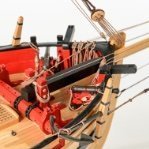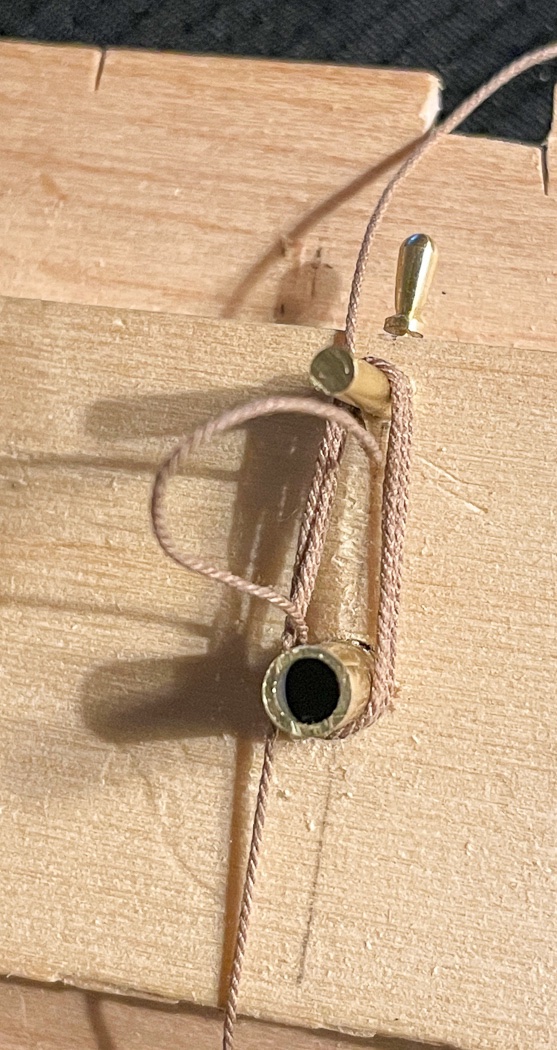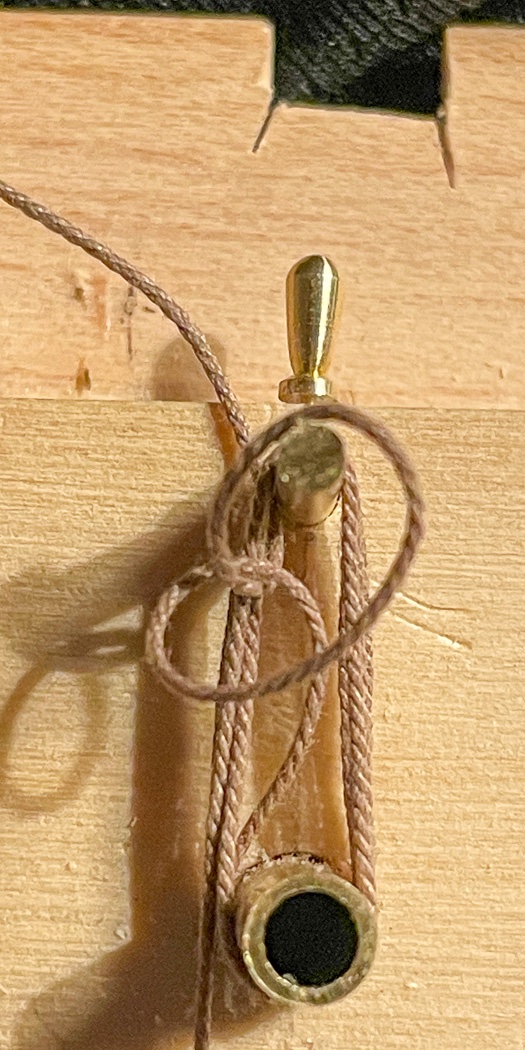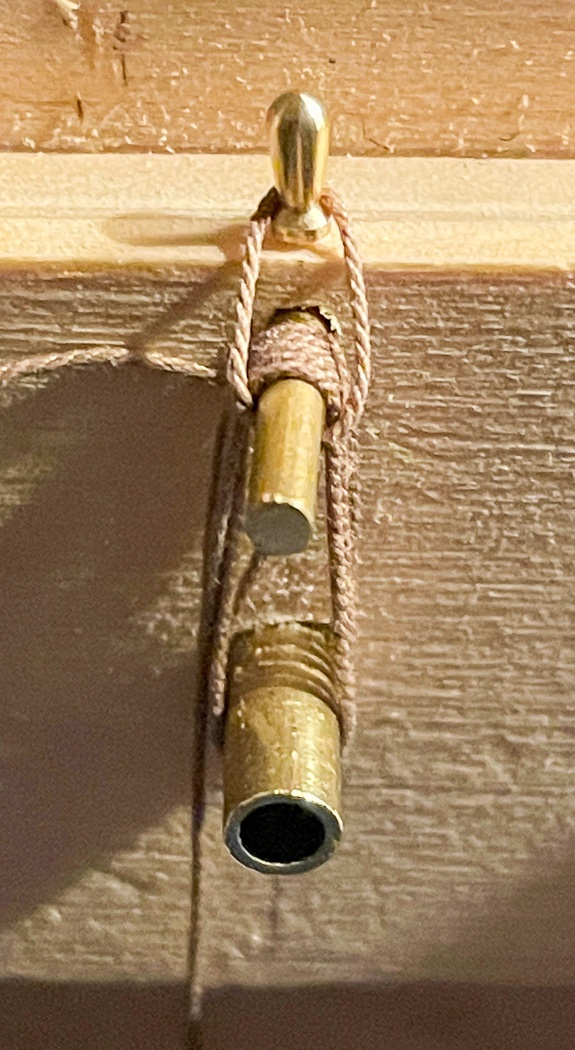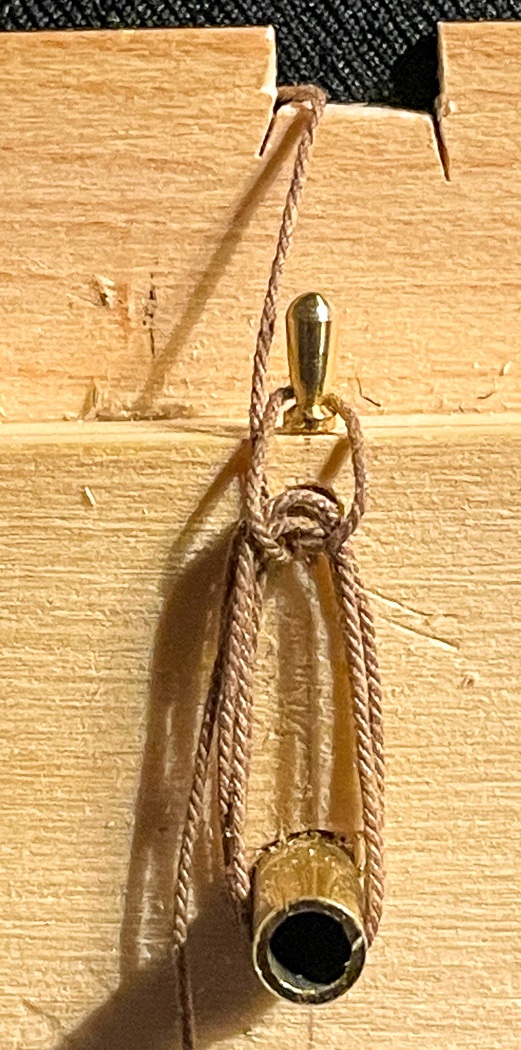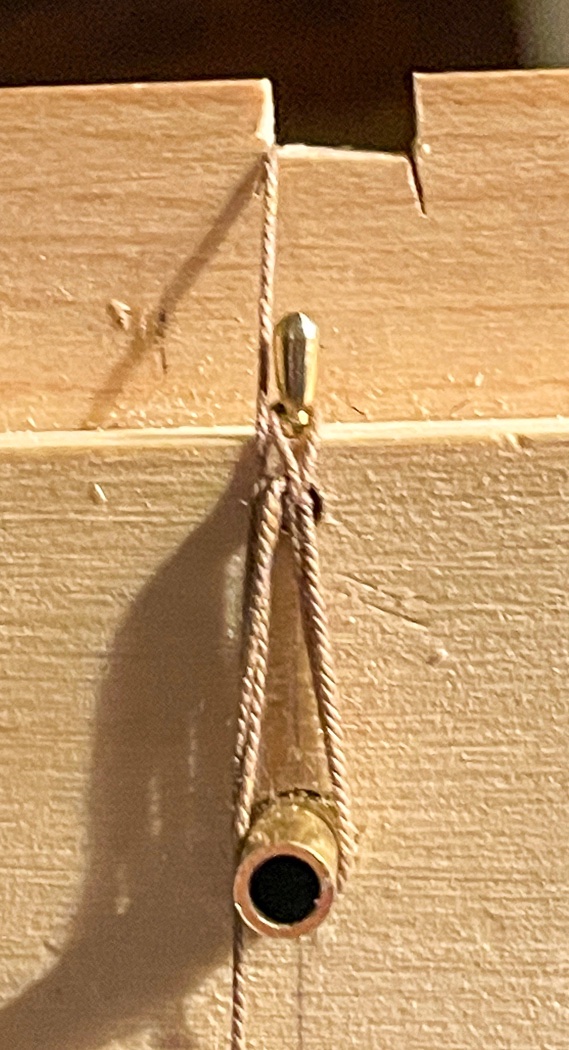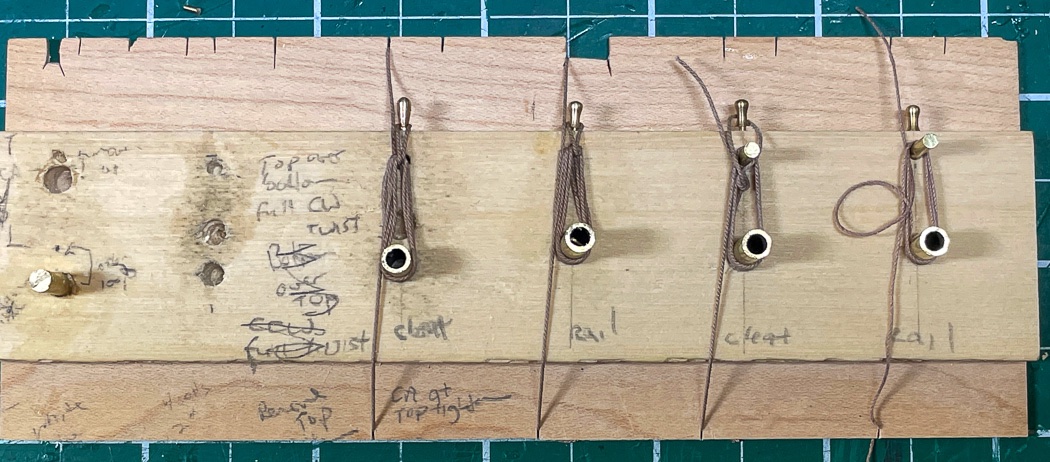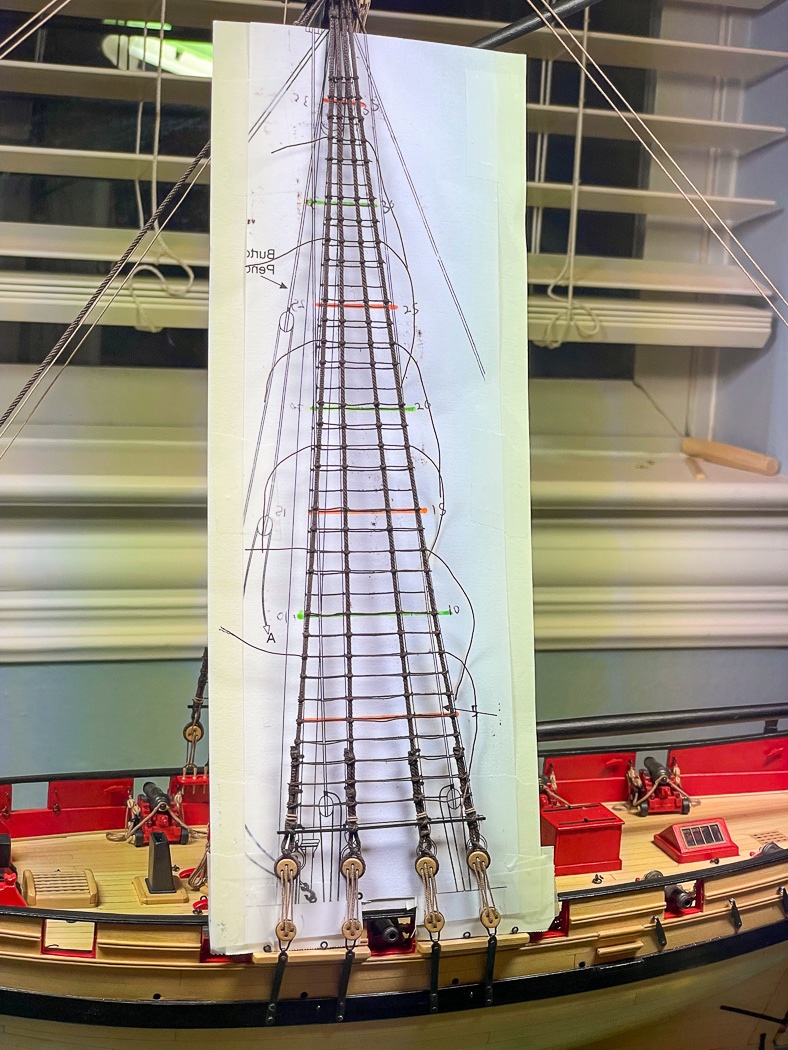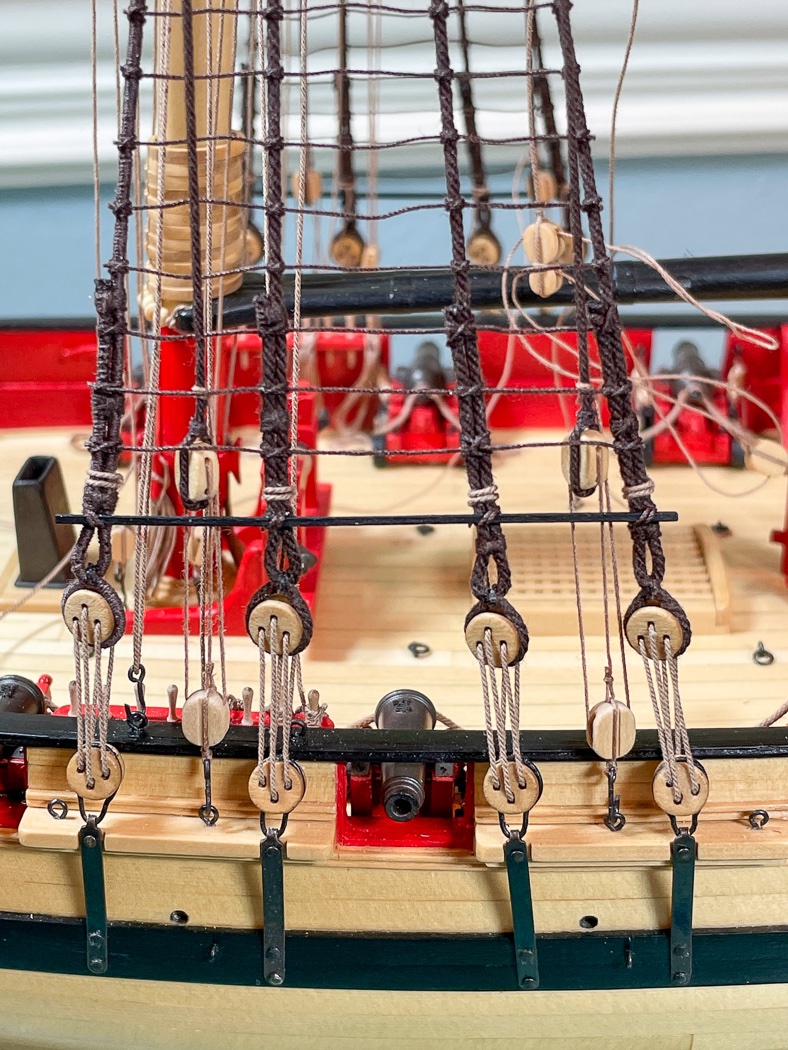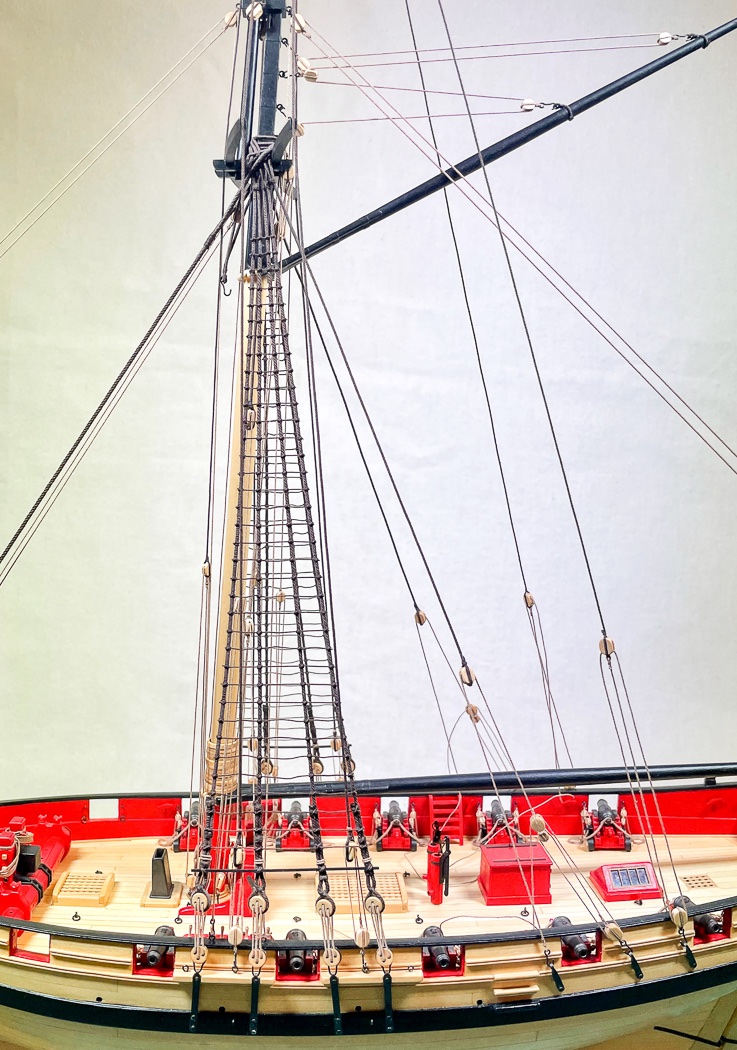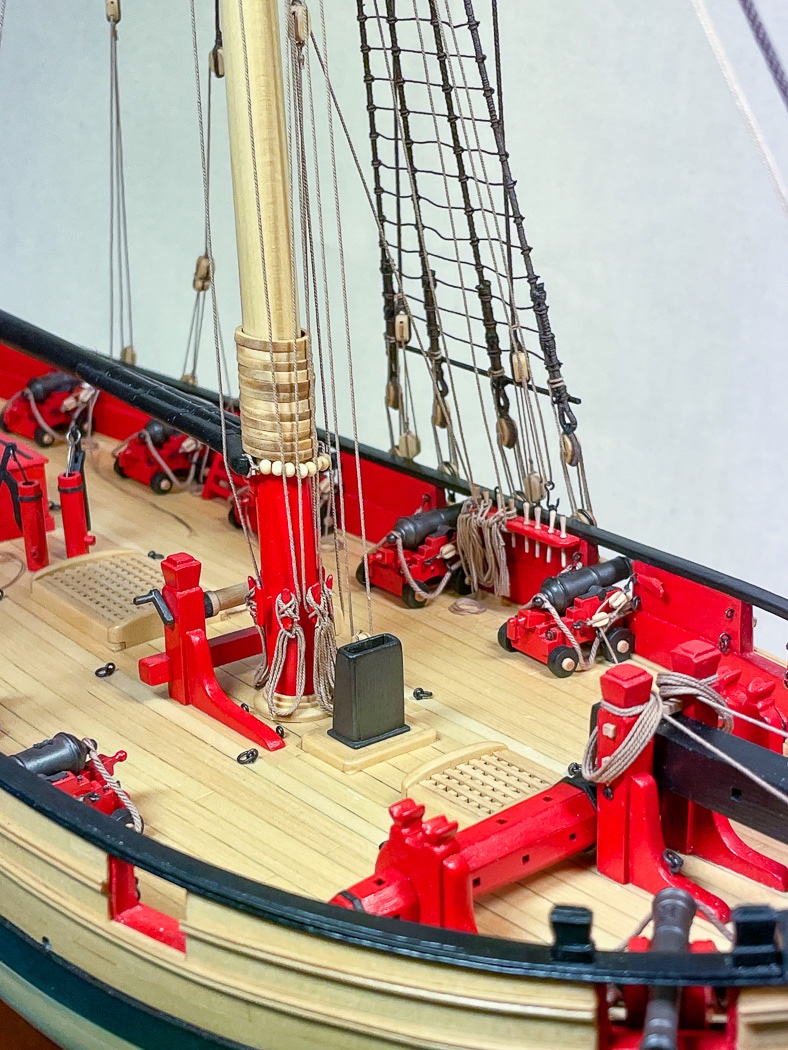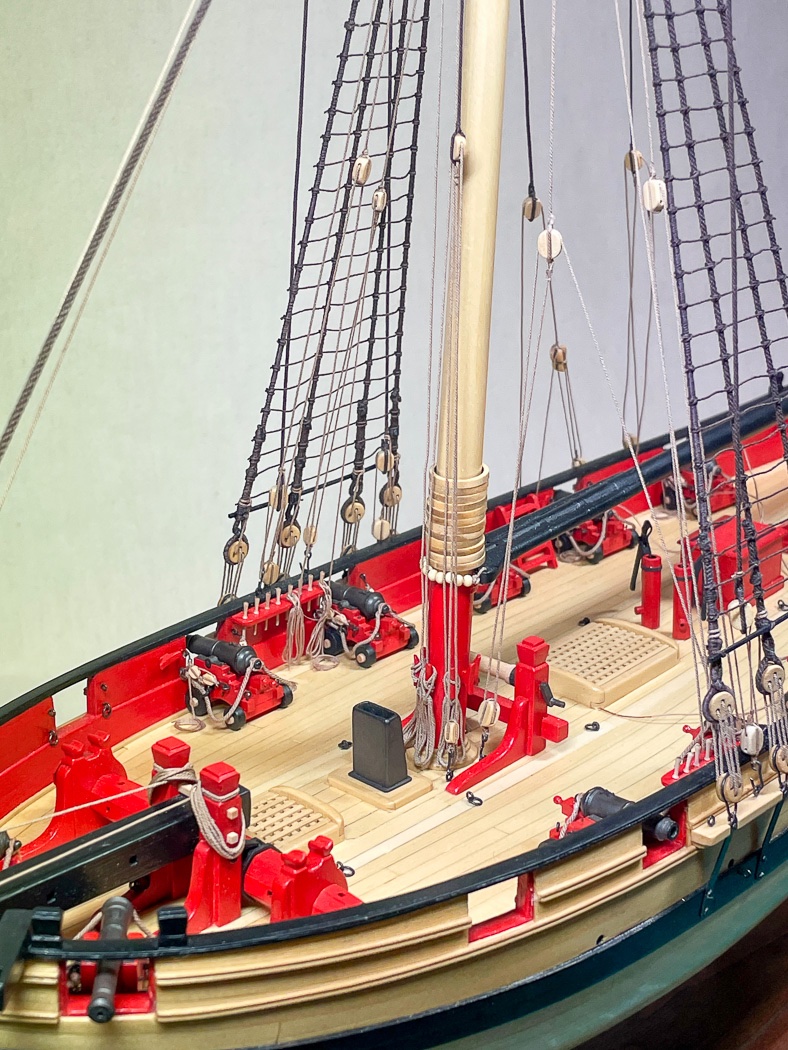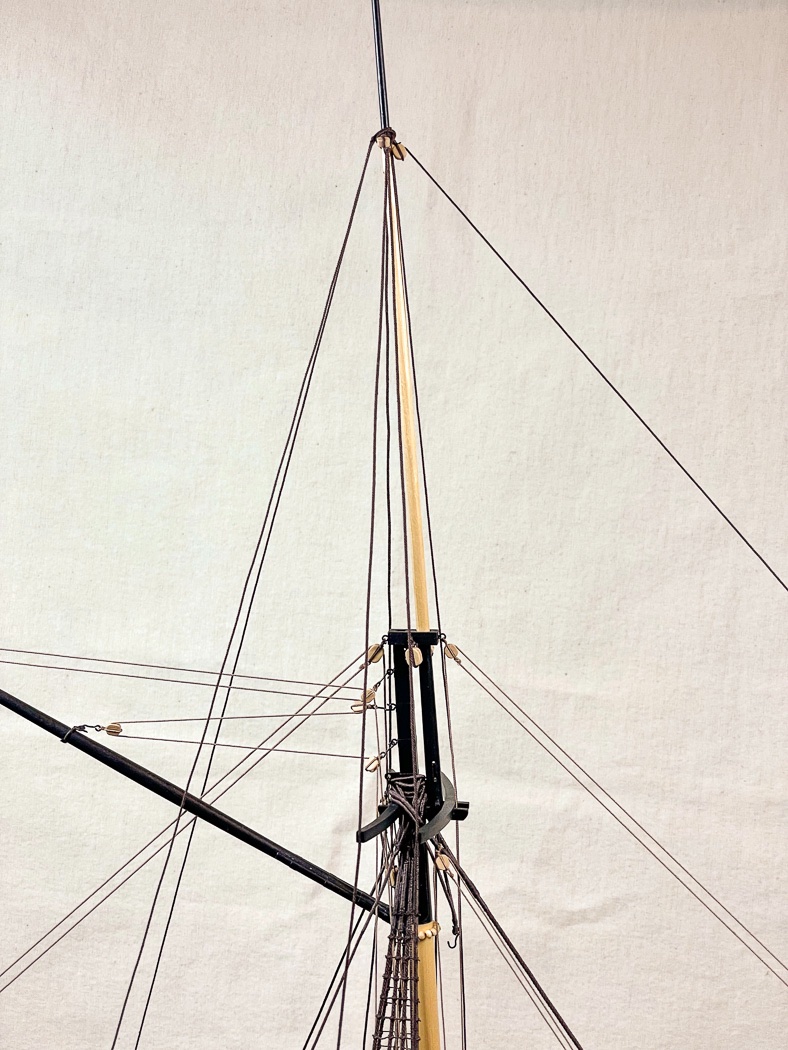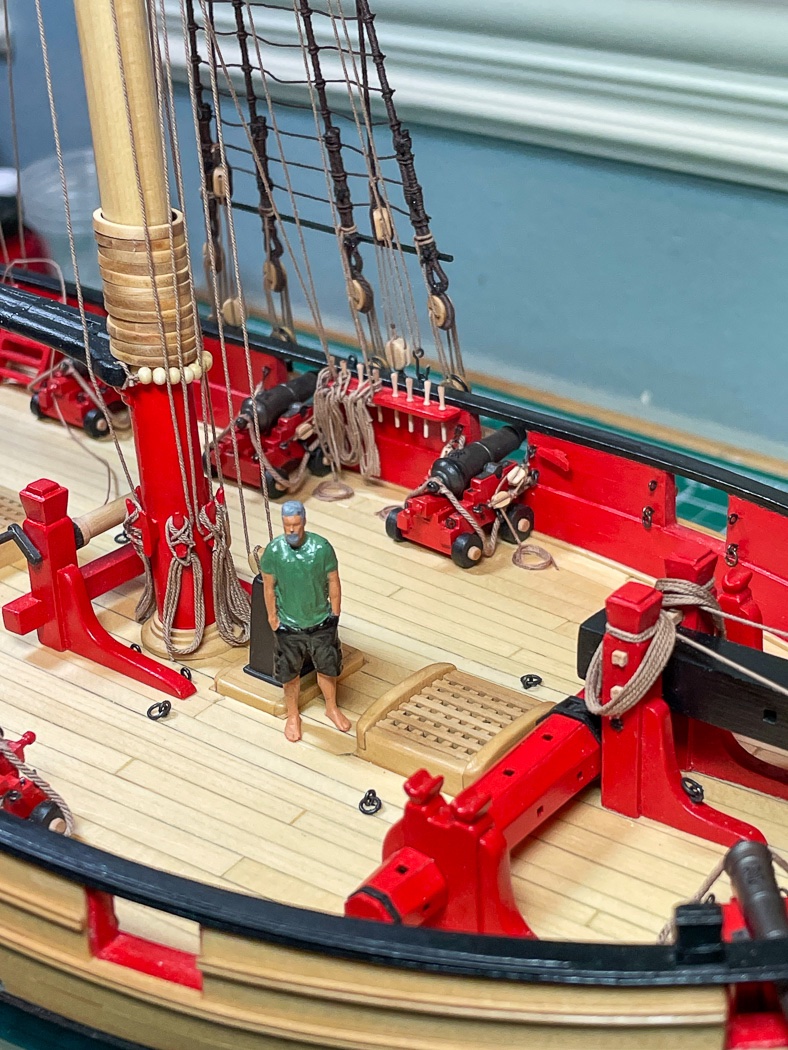-
Posts
4,097 -
Joined
-
Last visited
Content Type
Profiles
Forums
Gallery
Events
Everything posted by glbarlow
-
There is a lot of fairing to do, a lot of it at the bow. By the time it is done right you really don’t need filler, most of it would be faired away anyway. I can’t stress enough how important it is to spend time on the fairing, way more than any kit due to the single planking. When you think you have it faired, check and recheck with battens, especially at the bow. Did I mention getting bow faired well is important. As to where to start as Chuch says, whatever works. It’s all has to be done. I started at the bow and worked back both sides at a time but with multiple passes, no way I could get it right all at once.
- 274 replies
-
- Cheerful
- Syren Ship Model Company
-
(and 1 more)
Tagged with:
-
Thanks for the video. I terminate the line just as it shows but with a reverse loop at the end and less turns. I’ve been doing my actual boat that way for years, as the guy says, the friction holds it fast. Interesting to see how large the lines are on that ship.
- 778 replies
-
- cheerful
- Syren Ship Model Company
-
(and 1 more)
Tagged with:
-
Thanks for saying so. I still have more to add with the yards and to arbitrarily fill some of the empty pins after that. Every time I look at them I feel like I could make a better one but at some point I just have to move on. The technique works, it’s just that balance of not to stiff, don’t fall apart mix of the watered down glue.
- 778 replies
-
- cheerful
- Syren Ship Model Company
-
(and 1 more)
Tagged with:
-
I'm thrilled to see another Cheerful log, congratulations on a fine start. I'll follow along. You'll like how the Yellow Cedar looks once you've added Wipe On Poly (which I hope they have in Canada, apparently they don't in Europe).
- 274 replies
-
- Cheerful
- Syren Ship Model Company
-
(and 1 more)
Tagged with:
-
Thank you. Scotch maybe. I hope you can follow the rope coil section. I tried to explain it without writing more of a book than I did. Use scrap rope to practice, something I wish I'd done and saved a little good Syren rope.
- 778 replies
-
- cheerful
- Syren Ship Model Company
-
(and 1 more)
Tagged with:
-
Thanks Chuck, I kind of regret that - its been such a challenging and rewarding build. I'm going to miss it when it's finished.
- 778 replies
-
- cheerful
- Syren Ship Model Company
-
(and 1 more)
Tagged with:
-
It’s been a while since my last post, lots of stuff going on outside the shipyard. Ratlines Completed For all my delaying completing the ratlines wasn’t really that big a deal, it basically took me a days work for each side and was kind of relaxing in a weird way. Of course having only 4 shrouds per side and the the 1:48 scale made it simpler, but so did my revised method (from past models). I put my own spin on what I’d learned from several other build logs by scanning a copy of the plans, printing a copy for starboard, reversing the scanned image using Apple Preview and printing that for the port side. I mounted the paper on stiff card with the bottom the right height to match the sheer pole on paper to the one on the model. This saved me the step of making a grid but more importantly gave me good vertical lines to keep the shape right. My shrouds at the start weren’t an exact match to the plans, but they are very close and consistent enough to act as a guide. The spacings are correct, the angle of the photo or the paper leaning back throws off the aspect. I used .012 dark brown line (I should have been a hoarder, I’m going to miss Syren rope when mine runs out) I did them in sections, first the “five lines” which I’d highlighted in orange, then the “ten lines” in green ,then the three’s, ones, fours and twos. I glued each after I was done with a section, allowed them to dry and cut off the tails before doing the next section keeping the working field clean and lines from shifting. I did all the lines using clove hitches working left to right (because I’m left handed). If you use some other knot, even if only on the outside shrouds I highly recommend using clove hitches instead. Once I got going I was whipping across the shrouds, the clove hitch allows adjusting for the right tension easily and frankly just looks good. And then they were done. Another benefit of doing them in random spaced groups is I didn’t focus on ‘aargh…how many more rows until I get to the top….’ By doing sections I didn’t think about anything but that section and was almost surprised when there weren’t anymore to do. So I immediately strung 4 lines from my cabinet down to the worktop and weaved more ratlines for the pure joy of it….or maybe not. Rope Coils It was time to do final tension on lines, gluing them, and adding rope coils. I’ve again chosen to do them differently than on past models, I think the 1:48 scale makes me think differently. I went searching on MSW for ideas and found multiple posts on Flemish coils (which I’m not a fan of doing) however there wasn’t much on “working coils” or at least in a way I wanted to do them. I did locate a repost by @ccoyle of a method used by ‘Peter-V’ that served as a starting point, so credit and thanks to him and to Chris for further sharing it. I once again put my spin on it and wasted a bit of rope sorting out a look I liked. I also didn’t determine key steps (see below) until Googling rope coils and finding a series of images related to actual sailing. Side note for Cheerful builders, I went through a lot of .018 Light Brown rope, in fact I wouldn’t have had enough to finish the boat if I hadn’t ordered some for my next build of Flirt. I had to cut into that stock, a problem for another day. I thought I was fairly judicious but likely used too much for rope coils. One coil is a lot of rope and I have made and remade them. I probably could have been more efficient with the lengths of tackle. I’m sure it’s my fault, so just a heads up. I want the coils to look natural and each one be somewhat consistent but at the same time different from the one next to it - like the lines are in use, not inspection ready. Each one is made, then painted in very watered down white glue, then with a wet brush to avoid white glue staining. Once dry then smushed (that’s a technical term) with my finger and bent around to shape it to its location - again being different each time. After a few false starts I came up with this ‘rope board’ using brass tubing, brass rod, and brass belaying pins. All the brass is removable, which is essential to how I make them. There are two set up for pin rails and two for cleats and another just for straight up coils, the differences being the size of the eye and length of the coils (the board shows it took a few iterations to get there). I should do a separate post in the rigging forum to provide more detail from what I’ve learned, even more so since I took these photos. The short(er) version is to wrap the rope around the brass pins leaving the top extra long (it goes on for a few inches behind the board) before seating it in a split on the top, after 4-6 wraps (I varied them) the end of the rope seated in another split in the bottom. Loosen the top excess rope and grap the first (bottom) loop with tweezers (it’s tricky, sharp pointed tweezers are essential)and pull it out. Loop it top over bottom (not bottom over top) then do a complete 360 degree clockwise loop (not 180) (the two key steps I’d missed from the research) and place that over the belaying pin at the top. It represents the pin rail on the boat (or the top of a cleat). Snug that up with the top rope. Remove the top brass rod and tighten it further. Another lesson I learned is not too tight as it is in this photo - shape the loop a little. Then paint it all with watered down white glue. Remove the bottom brass rod after the glue dries and lift it off the board. Important point, I used a drop of CA (yes I like and use CA) on the back side of the coil’s top to seal the top rope that formed the loop (another lesson learned) before sniping of the excess of both the bottom and top ropes otherwise the whole thing may collapse into a wad (he said having done that). I then did the artistic smushing and bending before installing it on the ship. I hope that makes some sense, each one I make I do a little different but this is the essence of what I learned from others then modified to work for me. A final point, getting the watered down glue the right consistency is another key - so the rope is not too stiff or not to loose. I’m still working to finding the magic formula. Topmast Shrouds These can’t be done until the ratlines are complete they thread through the ratlines (for me the second and third) following a straight-line from the trees to their belaying points on the channels. Done with .35 dark brown rope looped seized in a loop at the topmast they end in ¼ blocks after being glued to the slots at the ends of the cross trees. It's important to get the line snug without being tight, the topmast is a relative toothpick and easy to bend. I glued both into the slots of the trees at the same time, tricky but helps keep an even tension. I used .012 light brown tackle starting from another ¼ block seized to a hook and to eyebolts in the channels. Seems easy enough and it should be but I must say I had a lot of “fiddling” to do to get them even, the right height, and the tackle seized back onto itself (like the main shrouds) while working between the ratlines. Patience and perseverance in abundance is called for, the first which I’m always wishing I had more. Topmast Stay It’s a bit difficult getting a good photo of this long run of .018 brown rope. I didn’t have the light right for and my temporary off-white backdrop has fold marks. I just hang a piece of cloth behind and tacked over the window for quick and easy progress photos, not how I formally shoot white background photos on rolled white paper. I’ll do better for finished photos (though at the moment my stands have been turned into an inside tent for my granddaughter, a far better use for them). It's made from lace and pink string lights, she asked for it the first day of her summer vacation and of course that's what I did. Anyway, the stay is seized at the bowsprit, I elected to match the main stay by leaving the seizing long then securing the extra length with two clove hitches. I thought it gave it a more finished look. The stay runs from there through a 3/16 block at the topmast and dangles about 140mm (really to where I thought it looked good) from the deck. A 3/16 block is seized with .018 tackle which runs through another 3/16 block seized to a hook (I’m getting pretty good at knocking hooks out from 24 gauge wire) into an eyebolt at the base of the mast then back through the upper block and finished off at a cleat on the mast. The plans do a great job of showing what rope and blocks to use in a table, how the run should look and includes an easy to follow belay map of the deck. I like sorting it all out from plans to model. If I haven’t mentioned the 3 sheets of plans are very well done and an excellent roadmap throughout the build. Topmast Backstays Chuck notes in the monograph while these are included in the plans in actuality they are rarely used and so are optional to install. I chose to include them because they provide a little balance to the stern and because I didn’t want the third outside metal strap left empty. Besides who doesn’t want to run more string about the boat. They consist of a long length of .018 brown line looped and seized at the topmast with ¼ blocks about 130mm above the deck where .018 light brown tackle is carried down to another ¼ block & hook connected to the third metal strap on the outside of the hull, back up to the block then finished at a cleat inside the bulwark. All of this is shown nicely on the plans. I have not tensioned and glued either these or the main backstays. I have to move them out of the way to access the pin rails and mast cleats for the remainder of the rigging. For a similar reason I haven’t glued in the tiller yet, I need the working room for my hands. Once I’m finished the rigging for the yards I’ll come back to the tiller and gluing in these stays. Standing Rigging With that I have completed all of Cheerful’s standing rigging and 13 of the 14 chapter monograph. I now turn to the making the yards (back to the lathe and mill) and the remainder of the running rigging. My journey is almost complete. Thanks for stopping by, as always I appreciate your likes and especially your comments. I hope you’re still finding the log enjoyable to follow.
- 778 replies
-
- cheerful
- Syren Ship Model Company
-
(and 1 more)
Tagged with:
-
So meticulous. Your painting and color choices are excellent, it looks natural and authentic, not over the top with the gold. Well done!
- 642 replies
-
- winchelsea
- Syren Ship Model Company
-
(and 1 more)
Tagged with:
-
More excellent tutorials on rigging. Well done. I did those toggles on Pegasus which after researching included every line it would had including sail handling as your doing. It looks great, but it is a lot of string.
- 725 replies
-
- vanguard models
- speedy
-
(and 1 more)
Tagged with:
-
Your photography has taken great leaps forward. I’m going to start a log on Flirt, it will have only one entry “See how to do it here” with a link to your Speedy log. That’s it log finished.
- 725 replies
-
- vanguard models
- speedy
-
(and 1 more)
Tagged with:
-
You’ll want to repair the top of the port with a piece of wood cut to fit and sand it back flush. That port as you see it is as it will look finished with only the cap rail on top. So you need to fill the gap now while it’s easy. (I did the same thing). It will be painted so it doesn’t have to match color. you’re making great progress! The fairing looks excellent.
-
That’s kind of you to say. Thank you!
- 778 replies
-
- cheerful
- Syren Ship Model Company
-
(and 1 more)
Tagged with:
-
Thanks. I’ll cover the rope coils in my next post after finishing the rat lines.
- 778 replies
-
- cheerful
- Syren Ship Model Company
-
(and 1 more)
Tagged with:
-
Check my log for my favorite home made rigging tool, a dowel and a needle is all you need plus a pair of cuticle cutters and sharp pointed tweezers. Work from the middle out and bottom up. Add what you can now in terms of eye bolts. Look ahead don’t wait till you need them. Install what you can off the ship. I have a few other suggestions on my Cheerful and Nelson logs. You’ll be fine. Other than ratlines I really enjoy rigging, I like the puzzle of making it all work. I added a number of lines to Nelson based on source material on cutters. What’s on the plans is pretty basic. Piece of cake.
- 139 replies
-
- Lady Nelson
- Amati
-
(and 2 more)
Tagged with:
-
I started with one once you started making your own parrels, you never cease to amaze.
- 725 replies
-
- vanguard models
- speedy
-
(and 1 more)
Tagged with:
-
This will one great guide for me when I start my barge. Nice work and wonderful descriptions.
- 185 replies
-
- queen anne barge
- Syren Ship Model Company
-
(and 1 more)
Tagged with:
-
Thanks. That.s my goal. Thank you, using the plans was a new twist. I’m either brilliant or too lazy to manually make up a separate grid on paper 😂
- 778 replies
-
- cheerful
- Syren Ship Model Company
-
(and 1 more)
Tagged with:
-
Nice work! That’s a lot of magnets you have there.
- 28 replies
-
- Amati
- Lady Nelson
-
(and 2 more)
Tagged with:
About us
Modelshipworld - Advancing Ship Modeling through Research
SSL Secured
Your security is important for us so this Website is SSL-Secured
NRG Mailing Address
Nautical Research Guild
237 South Lincoln Street
Westmont IL, 60559-1917
Model Ship World ® and the MSW logo are Registered Trademarks, and belong to the Nautical Research Guild (United States Patent and Trademark Office: No. 6,929,264 & No. 6,929,274, registered Dec. 20, 2022)
Helpful Links
About the NRG
If you enjoy building ship models that are historically accurate as well as beautiful, then The Nautical Research Guild (NRG) is just right for you.
The Guild is a non-profit educational organization whose mission is to “Advance Ship Modeling Through Research”. We provide support to our members in their efforts to raise the quality of their model ships.
The Nautical Research Guild has published our world-renowned quarterly magazine, The Nautical Research Journal, since 1955. The pages of the Journal are full of articles by accomplished ship modelers who show you how they create those exquisite details on their models, and by maritime historians who show you the correct details to build. The Journal is available in both print and digital editions. Go to the NRG web site (www.thenrg.org) to download a complimentary digital copy of the Journal. The NRG also publishes plan sets, books and compilations of back issues of the Journal and the former Ships in Scale and Model Ship Builder magazines.


